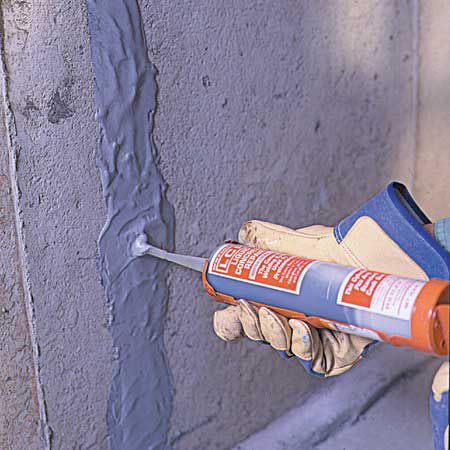


If a coating, sealant or paint has been applied to the concrete, it must be removed before placing the paste-over epoxy. Blow any remaining water from the crack with clean compressed air.Remove residue by high-pressure washing or steam cleaning.Using clean, compressed air, blow out any remaining debris and liquid.Where a surfacing material has been removed using an acid or chemical solvent, prepare the crack as follows: Other materials such as polyurethane resins may be required to repair an actively leaking crack.įor many applications, additional preparation is necessary in order to seal the crack. If water is continually seeping from the crack, the flow must be stopped in order for epoxy injection to yield a suitable repair. Best results will be obtained if the crack is dry at the time of injection. Using clean, oil-free compressed air, blow out the crack to remove any dust, debris or standing water. Take care not to impact any debris into the crack during cleaning. Oil, grease or other surface contaminant must be removed in order to allow the paste-over to bond properly. At a minimum, the surface to receive paste-over should be brushed with a wire brush.
 E-Z-Click™ injection ports, fittings and other suitable accessories.Įstimating Guide for Epoxy Crack Injection Preparation of the Crack for InjectionĬlean the crack and the surface surrounding it to allow the paste-over to bond to sound concrete. CIP-LO, CIP-F and ETR are recommended for paste-over of crack surface and installation of injection ports. Crack-Pac Flex-H2O polyurethane crack sealer for repair of fine- to medium-width cracks (suggested width range: 1/32"–1/4"). Crack-Pac® injection epoxy for repair of fine to medium non-structural cracks (suggested width range: 1/64"–1/4. CI-GV for repair of medium-width cracks (suggested width range: 3/32"–1/4"). CI-LV FS and CI-LPL for repair of fine to medium-width cracks (suggested width range: 1/64"–1⁄4. CI-LV and CI-SLV for repair of hairline cracks (0.002") and those up to 1/4" in width. If the source of cracking has not been determined and remedied, the concrete may crack again. Prior to doing any injection it is necessary to determine the cause of the crack. Due to the variability of field conditions, selection of the proper material for the intended application and installation is the sole responsibility of the applicator.Įpoxy injection is an economical method of repairing non-moving cracks in concrete walls, slabs, columns and piers and is capable of restoring the concrete to its pre-cracked strength. Important: These instructions are intended as recommended guidelines. Simpson Strong-Tie Research and Testing Laboratory at WSU. Simpson Strong-Tie Materials Demonstration Laboratory at Cal Poly. New Product Testing in a Virtual Environment. Outdoor Living: Where Great Backyards Begin. Soft-Story Retrofit for Building Owners.
E-Z-Click™ injection ports, fittings and other suitable accessories.Įstimating Guide for Epoxy Crack Injection Preparation of the Crack for InjectionĬlean the crack and the surface surrounding it to allow the paste-over to bond to sound concrete. CIP-LO, CIP-F and ETR are recommended for paste-over of crack surface and installation of injection ports. Crack-Pac Flex-H2O polyurethane crack sealer for repair of fine- to medium-width cracks (suggested width range: 1/32"–1/4"). Crack-Pac® injection epoxy for repair of fine to medium non-structural cracks (suggested width range: 1/64"–1/4. CI-GV for repair of medium-width cracks (suggested width range: 3/32"–1/4"). CI-LV FS and CI-LPL for repair of fine to medium-width cracks (suggested width range: 1/64"–1⁄4. CI-LV and CI-SLV for repair of hairline cracks (0.002") and those up to 1/4" in width. If the source of cracking has not been determined and remedied, the concrete may crack again. Prior to doing any injection it is necessary to determine the cause of the crack. Due to the variability of field conditions, selection of the proper material for the intended application and installation is the sole responsibility of the applicator.Įpoxy injection is an economical method of repairing non-moving cracks in concrete walls, slabs, columns and piers and is capable of restoring the concrete to its pre-cracked strength. Important: These instructions are intended as recommended guidelines. Simpson Strong-Tie Research and Testing Laboratory at WSU. Simpson Strong-Tie Materials Demonstration Laboratory at Cal Poly. New Product Testing in a Virtual Environment. Outdoor Living: Where Great Backyards Begin. Soft-Story Retrofit for Building Owners. Epoxy resin slab crack repair software#
Component Manufacturer Software Solutions.Anchoring Solutions for Value-Added Manufacturing.Cross-Laminated Timber (CLT) & Mass Timber Connector Products.Unreinforced Masonry (URM) Building Retrofit.Repair, Protection & Strengthening Systems.







 0 kommentar(er)
0 kommentar(er)
